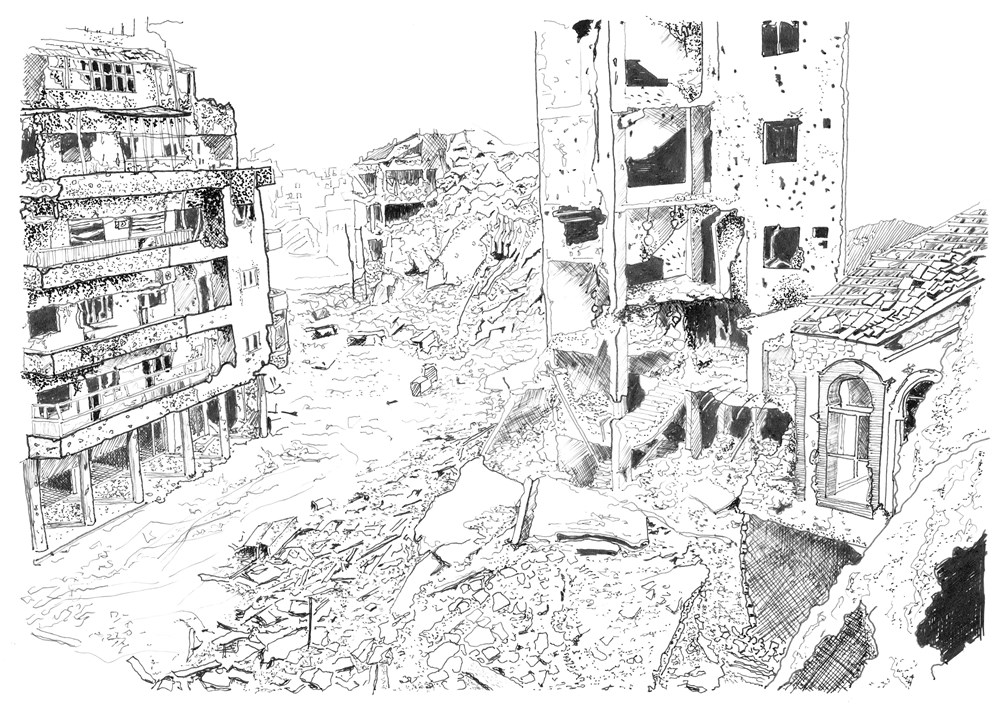“Air currents from the sea made summers in Homs more bearable than in other Syrian cities. This wind also left its mark on the trees, which are all bent towards the east. You always know that you have entered Homs when you see these bent trees along the roadside”.
excerpt from The Battle for Home: The Memoir of a Syrian Architect, by Marwa al-Sabouni. Pema Monaghan spoke with al-Sabouni ahead of her appearance at the 2017 Perth Writers Festival.
Pema Monaghan: You write about Homs, particularly the old city, lyrically and poetically, invoking beautiful details about wind, trees, stone, windows, and fruit. How can architecture be designed poetically, or designed to inspire poetry?
Marwa al-Sabouni: Poetry to begin with was considered a real craft for the Old Arabs, as the Arabic language offers a tremendous capability of expansion and contraction within a special system of rules; so it is not only an art of images but also a craft of wording. To capture the big picture is to see all the small details, and describe how they relate and interact with each other. This for me is a job for architecture as to poetry and as to any other form of expressive art.
Are there particular parts of Homs that are becoming inhabited and lifelike again? Are people resettling in a way that reflects the cultural divisions you have described from before the war?
Homs wasn’t emptied out of people completely; certain neighborhoods were wiped out, while others have suffered battling without destruction; there is where people have remained and where others have returned too after a while. Demographically; some places have kept their character while others had to adapt to a new situation.
You write with frustration about the social and political systems in Homs that resulted in the restriction of its architecture and also of your own education as an architect. You also called your work The Battle for Home. Why do you think we wish to stay and reform, or rebuild, our “homes”, despite the ways they can betray or limit us?
First because they are our home; the places and the people that have become part of who we are since our first encounter with world. Second, is because the world is capable of frustrating us wherever we go; this is part of the ‘deal of life’ I believe, not something that we can escape. And lastly, is because life would have no meaning if we managed to escape its challenges.
What do you find exciting about the current reconstruction of Homs? What do you find disappointing or dismaying?
Whatever I feel it is definitely not excitement; it is a huge responsibility for every citizen and inhabitant of this place to even witness what it might be turned into. Between the misery and struggle of huge numbers of people, and the greed and corruption of as many too; building a home and building communities is a subject that can be overthrown very easily as it can be missed up just as easily. So, my hope is that there will be enough good will to pull all this through.
Architecture bears physical witness to trauma. How can Homs be rebuilt in a way that progresses the city away from the issues that you raise in the book, and away from the war itself, while still retaining the memory and lessons of the war? Do you believe that those experiences should be retained on a societal/architectural level?
Memory is a very sensitive issue in post-civil war contexts; just as Kosovo, Beirut and Kabul have shown us. The post- actual war phase is definitely a war on its own right; particularly on issues such as memory for example. In civil wars there are no winners, everybody is a loser even those who have the final say on ground. Everyone wants to perpetuate their own narratives, the very narratives which were subject of conflict. Expectedly, any permanent reminder of this (whether a building, a statue, or a work of art) can be counted as a provocative act to the ‘others’. Nor avoidance holds the answer as it is a psychological need for people to be able to remember their pain. however, it takes an incredible amount of skillfulness and delicacy to do it properly in an environment of internal conflict. The search for a common pain is not easy, but it must be done as a crucial step in the process of healing.
How can a city be built and updated in a way that makes it open, affordable, and welcoming to outsiders and newcomers?
This is a very important question, but also a very big one – big as a book I think! But what I have to say is that there is no one ‘remedy’ for all illnesses our cities might suffer from. We should avoid to be tempted to search for one fixed prescription, and try to assess small individual cases one by one. But in general; I think all cities should support the small things they have against the big ones; small business, small uses, small corners, and so on. And they should pay more attention to what is available rather than to what can replace it.
Interview by Pema Monaghan
Marwa al-Sabouni will present the closing address at the Perth Writer’s Festival on Sun 26 Feb as part of PIAF 2017. Al-Sabouni is also the co-founder of Arch-News.

